The Clevo P870DM2 / Mythlogic Phobos 8716 Laptop Review: DTR With GTX 1080
by Brett Howse on October 27, 2016 2:00 PM ESTSystem Performance
Although there are several processor options in the Clevo P870DM2, Mythlogic has outfitted the review unit with the highest performance model they offer: the Intel Core i7-6700K. For those familiar with Intel’s lineup of processors, they offer several model lines, with the lowest power ones being the Y series, which are 4.5-Watt, and then the 15/28W U series, and then the highest tier of their mobile processors in the H and HQ, with the latter being the quad-core mobile parts. These top out at 45-Watts, and we see them in almost all gaming laptops. Clevo is marketing this as a desktop replacement, and as such, every processor option is from the Desktop lineup. The majority of the processor options are in the 65-Watt series from Intel S lineup, featuring quad-cores and 6 MB of cache. The processor in the Phobos 8716 review unit is from the K series, with a 91-Watt TDP, 4.0-4.2 GHz, 8 MB of cache, and it is unlocked for overclocking. From a power perspective, the Core i7-6700K has just over twice the thermal headroom of a typical H series processor found in a gaming notebook. Twice the TDP doesn’t mean twice the performance, of course, but there is certainly a lot more potential performance on tap than any H series could offer.
To see how much performance is available, the Clevo P870DM2 was run through our standard lineup of tests, and then compared against several other systems. Of particular interest will be comparisons against the last Desktop Replacement notebook that we tested in the Clevo P750ZM, which was outfitted with the Devil’s Canyon Core i7-4790K, and that CPU actually has a slight frequency advantage over the i7-6700K, with the former topping out at 4.4 GHz and the latter at 4.2 GHz, but with the advantage of the Skylake architecture versus the Haswell architecture in Devil’s Canyon. As always, check out our notebook bench if you’d like to compare this laptop to any other we have tested.
PCMark

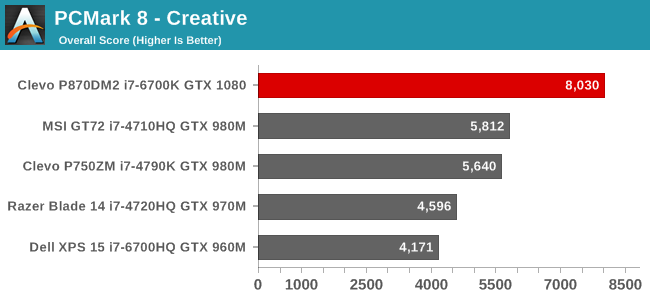

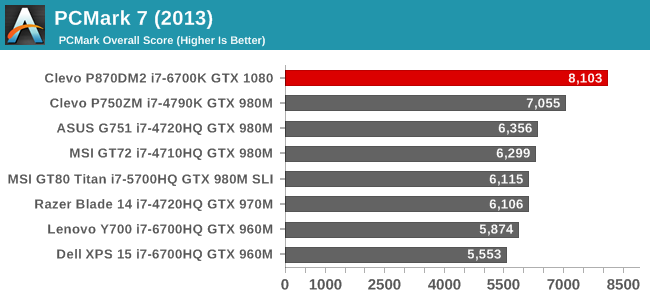
Our first tests are from Futuremark’s PCMark benchmark. This test runs through several real-world applications, and is a complete system test, from the storage to the CPU to the GPU. The Phobos 8716 sets a new bar here for performance in a notebook. That’s not surprising since it has the fastest CPU, the fastest GPU, and the fastest SSD in the Samsung 950 Pro.
Cinebench
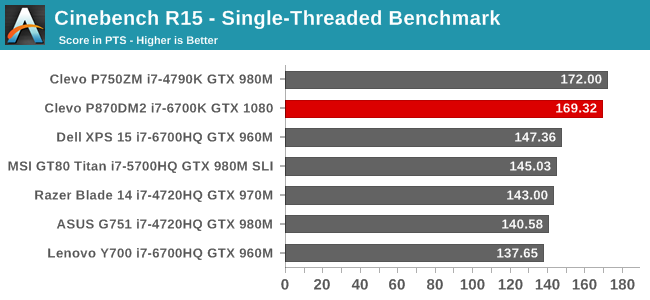
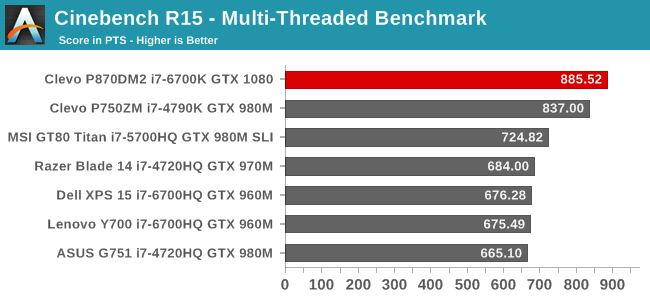
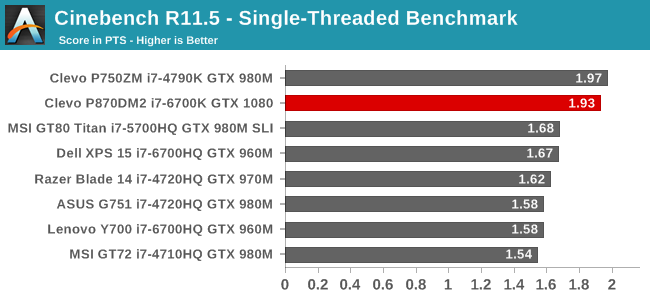
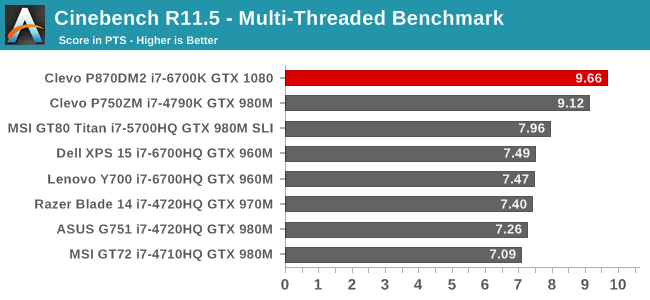
This test tends to be focused on pure CPU performance, and more cores with higher frequencies tend to dominate on this test. We can see that as well with the Devil’s Canyon in the P750ZM slightly edging the Skylake i7-6700K, thanks to a higher turbo frequency available, but only on the single-core tests. On the multi-core tests, the Skylake pulls ahead with its more advanced multi-core turbo, and benefits like Speed Shift.
x264
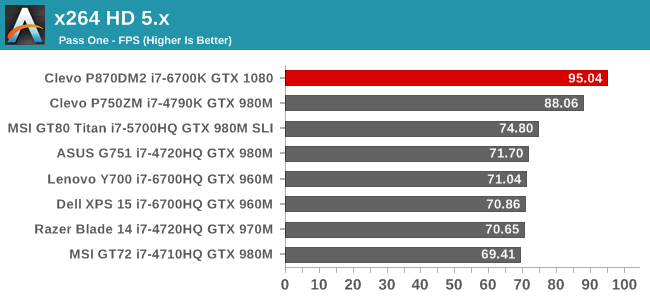
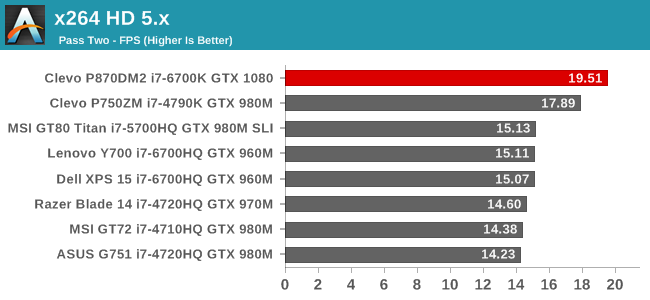
The better multi-core performance of Skylake once again pulls ahead easily here, with performance significantly better than the Haswell Devil’s Canyon.
Web Tests
Finally, web performance is always a priority, although it can be heavily influenced by the browser and platform. It is still something that everyone does every day. When Windows 10 launched, we switched to Edge for our tests, from Chrome on previous versions of Windows. Each browser is marked in the results.

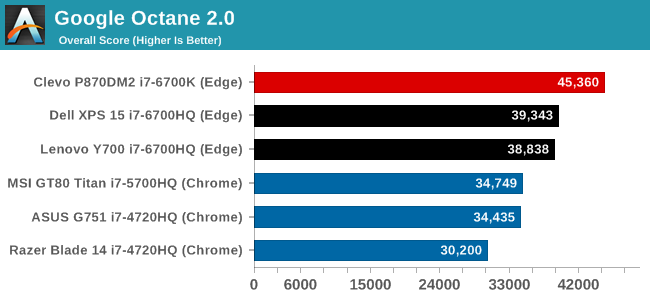


It should come as no surprise after the previous benchmarks that the Clevo P870DM2 / Mythlogic Phobos 8716 easily trounces all previous computers on our web benchmarks as well. Packing a desktop CPU into a notebook has some drawbacks in terms of heat dissipation, but at the end of the day the performance is a good jump ahead of any of the H series processors.
Storage Performance
As with any of these boutique computers, there is quite a bit of customization available on all of the components, and the storage is no exception. For the review unit, Mythologic supplied the Samsung 950 Pro NVMe SSD, and if you saw the review on that drive, you’d be aware that it is one of the fastest consumer SSDs available today, and in fact was only recently pipped with the introduction of the 960 Pro.
With the 256 GB model which is in the review unit, there are not the maximum amount of NAND dies to give the maximum performance, but regardless the results are still very, very good. Read rates approaching 2000 MB/s is likely going to be enough for almost anyone. Mythlogic will outfit the Phobos 8716 in multiple ways, and there are actually two M.2 slots if you need more SSD storage, and also two 2.5-inch SATA slots as well if you need a bit more bulk storage for game downloads.


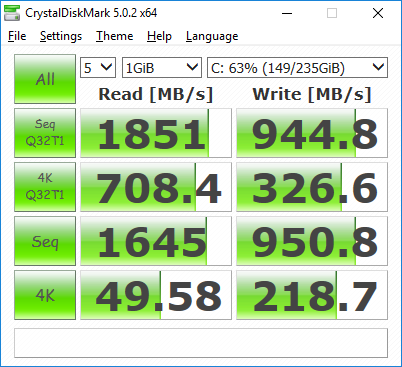








61 Comments
View All Comments
ZeDestructor - Saturday, October 29, 2016 - link
You should give it a go in current versions of VMware.. I hear decent things about it...chezfromage - Thursday, October 27, 2016 - link
As it turns out, I fit into this machine's target market (I'm paralyzed from a spinal cord injury, so I need a laptop, but I also do programming and rendering, so I need an overpowered monstrosity), and I just got the Sager version of this laptop (NP9873) a few weeks ago. First of all, I chose some higher-end specs than the reviewed device: 4K display; dual 1080s; a 512 GB 950 Pro primary SSD (plus another SSD and two HDDs); and the Intel 8260 wireless option. It has the same 6700k. The machine truly is a monster - with the dual 1080s, everything I've thrown at it so far runs 60+ fps set to 4K and ultra settings, albeit sometimes dropping down to FXAA on extremely demanding games (huge difference vs. MSAA on XCOM 2, for example). That low-ish number for Civ 6 as cited in the article has been fixed with an NVidia driver update, btw.Regarding stuff mentioned in the article and other comments, yes, the included control center and overclocking software is Clevo-developed and is the same on my Sager. It works well and lets you tweak values on the fly... Not that you really want to that much. Adjusting the core multipliers even just to 4.4ghz makes the fans kick in at full blast, which is insanely loud. Also, yes, the dual power adapter requirement is inconvenient but mildly hilarious; don't pretend this machine is particularly portable, although it's much easier than carting around a desktop with the same specs, which I think is the point.
Elsewhere, yup, the keyboard's a bummer, but the touchpad is surprisingly good! I can't physically perform most gestures (SCI hand paralysis), but one- and finger functions work flawlessly, and while the L/R buttons aren't the best, at least they're there.
Anyway, that's my experience with the dual-GPU option, if anyone was wondering. Any questions? Did I forget anything?
Edit: The 512GB 950 Pro is indeed way faster than the 256GB model - even with AES encryption via Veracrypt, it still benches at 2600r/1600w.
kmmatney - Thursday, October 27, 2016 - link
I've been using a 17" laptop for the last 10 years, and am a big fan of the DTR, but this is ridiculous. This should be a new category called GRR (Gaming Rig Replacement). I've had no trouble toting my laptops around, but mine are more in the 7-8 pound range. The Dell Alienware systems are good mix of gaming and portability IMO, but even a $500 Dell Inspiron can be a DTR these days,tagi123 - Friday, October 28, 2016 - link
It sure is ugly - as are all these 1080 laptops..s.yu - Tuesday, November 1, 2016 - link
I would love a review of the Blade Pro from Anandtech.Laststop311 - Thursday, November 3, 2016 - link
Such a narrow niche for a product like this. I mean really. speccing this thing out nice you are going to hit 3500-4000. You can simply get an awesome performing 20-25 poundish mid atx desktop and spend 2500 dollars and have a much easier time upgrading it and cleaning it and throw the remaining 1500 into a very very nice ultrabook with 10+ battery hours and all the performance ud ever need for on the go lap use. At least I think the majority of people would rather spend their money that way.Laststop311 - Thursday, November 3, 2016 - link
I can't be a hater tho I actually did use to own an alienware m18xr2 fully specced out with the gtx 880m sli. But this was when i went to a lot of LAN gaming parties and I still had to lug around my 22" high refresh gaming monitor and mechanical keyboard and mouse along with it.That's when I realized why am I bothering trying to be portable with a DTR. Nowadays you can build mini-itx systems that weigh only a bit more than this system with internal power supplies and much easier maintenance for much less money. Infact the ncase m1 mini-itx case only weighs 6 pounds before you add components. a Mini itx mobo can be had for 1.25 pounds an m2 ssd + 2.5" ssd barely adds any weight. a decent air cooler and fan in under a pound. You could easily build a mini-itx ncase m1 build for LESS weight than this laptop not counting the monitor keyboard and mouse you would have to lug around but if you were going somewhere that already had monitors you could actually carry less weight building a full fledged mini itx pc that will be way easier to clean and upgrade and way cheaper.
Laststop311 - Thursday, November 3, 2016 - link
oh did i mention the cooling will be quieter and better on the itx system as wellspeculatrix - Sunday, November 6, 2016 - link
It seem to have HUGE fans.It occurs to me that they should make the fans blow downwards, and then you can ride it like a hoverboard.
bennyg - Tuesday, November 15, 2016 - link
It's the Dodge Ram of laptops. Impractical. Thirsty. Expensive. Hideous. But ohmahgerd the powah. The catch 22 is that while it's built for overclocking it has so much power compared to normal laptops it is completely unnecessary! Maybe in 3 years time when it's superceded that will become useful. Unlike a Ram, which would have fallen to pieces by then. The amazing thing is that with desktop class components it still gets 2 hours life away from the wall plug!